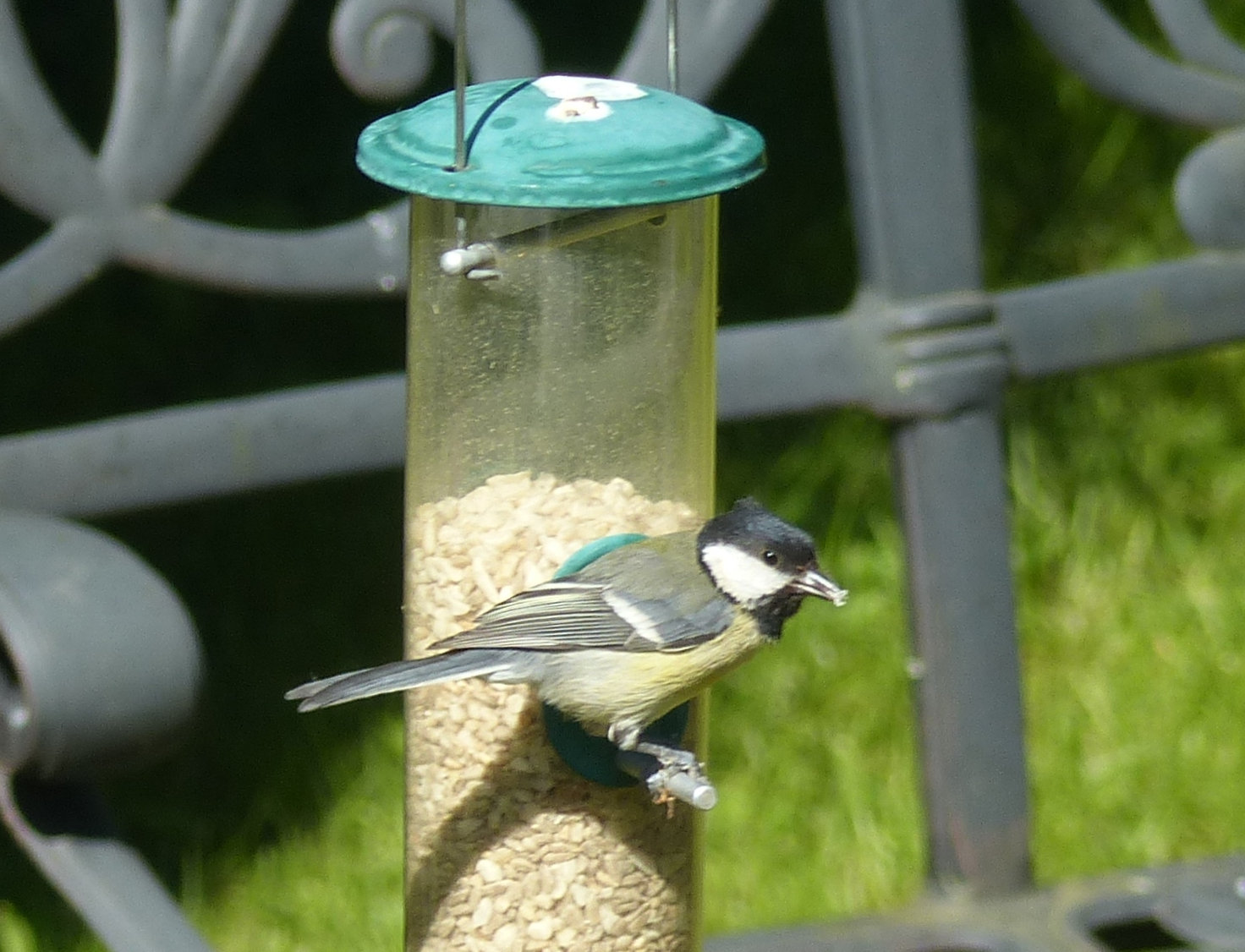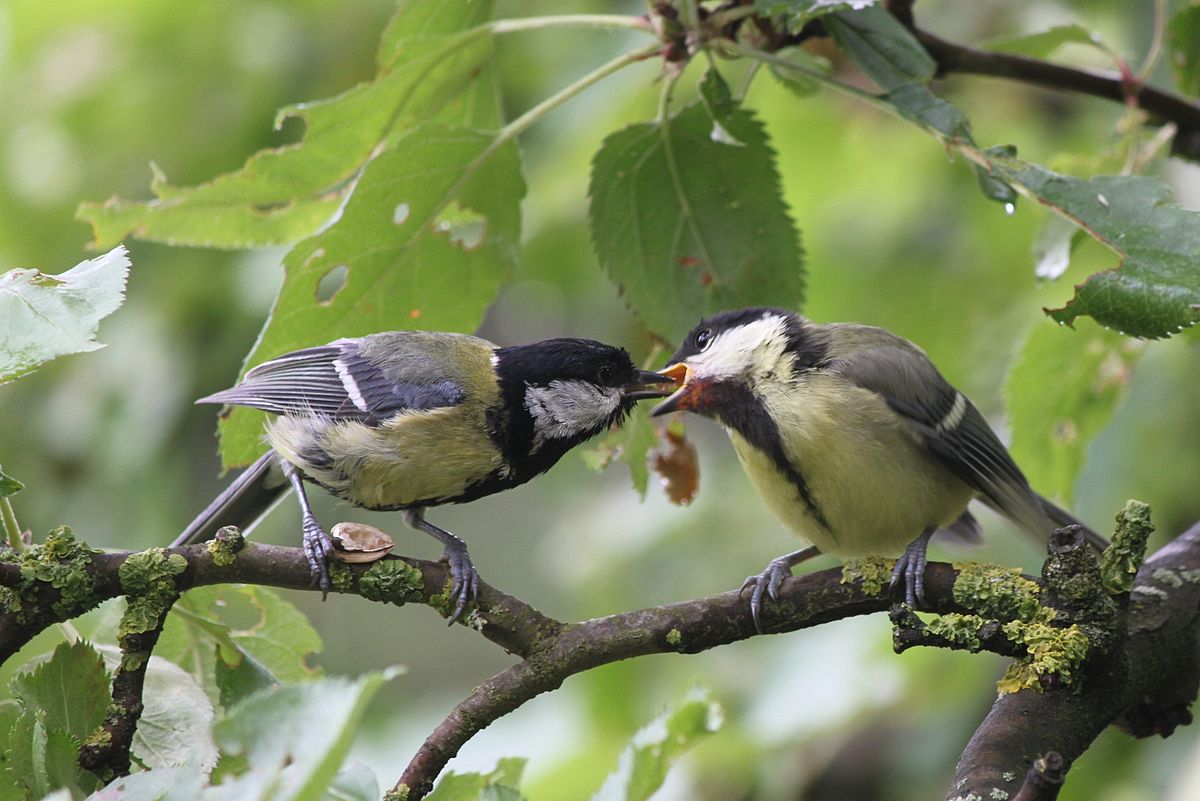Garden Wildlife
Garden Wildlife


Great Tit Parus major
Regularly counted in the top five commonest garden birds. They have a very wide range across the Northern Hemisphere and throughout Britain and Ireland.
What do they eat?
Great tits tend to be insectivorous during the warmer seasons but certainly take a lot of seeds and fats put out by humans.
What do they do?
Great tits behave pretty much like blue tits. They nest in holes (often in nest boxes). They are acrobats, hanging at all sorts of angles in the twigs and leaves whilst seeking food. Their broods are a little smaller on average than blue tits, around 8-10 eggs.
Great tits tend to be sedentary birds, moving only short distances from their birthplace. In winter non-breeders gather in flocks with other tits and finches and wander about, but males may remain in their own territory the whole year round. Ringing records indicate a few cases of further spread.
How are they doing?
The BTO Breeding Bird Survey 2019 suggests they have increased considerably in number over the last 25 years.There were thought to be 2.4 million territories in Britain in 2016. Like blue tits, it is thought that provision of artificial feeding in gardens is giving them an advantage over more timid species.
Finding out more:
BTO profile on great tit
RSPB profile on great tit
Page written by Roy Smith, compiled by Steve Head
Typical view on a feeder Adult feeding a juvenile (on the right)
What do they look like?
A bit bigger (14cm) than a blue tit, about the same size as a robin. The head is black with broad white cheeks. The black chin patch is extended down into a broad stripe of black in the centre of the breast – broader and very prominent in males, less so in females. The more prominent the stripe, the higher the social rank of the bird. The breast and flanks are yellowish green, the back darker olive green, the rump blue-grey. This extends down the centre of the tail, which has black borders and a white edge. The wings are greyish-blue, with a dull white bar. Juveniles are similar with a dull greyish cream background colour all over. See our tits page to compare with other species.
What do they sound like?
The most obvious great tit song is its repetitive territorial call – ‘teee tchaaa’ – although this is very variable, and often sounds like something else entirely. If you hear a loud unfamiliar call in the woods in Spring, check out if it is a great tit! Here are a few examples:

Susanne Kuijpers, XC644789. Accessible at www.xeno-canto.org/644789
Hannu Varkki, XC642519. Accessible at www.xeno-canto.org/642519.
Frode Falkenberg, XC645694. Accessible at www.xeno-canto.org/645694.
They also make softer chuckling and churring noises as alarm and contact calls:
Susanne Kuijpers, XC645116. Accessible at www.xeno-canto.org/645116
Great Tit Parus major
Regularly counted in the top five commonest garden birds. They have a very wide range across the Northern Hemisphere and throughout Britain and Ireland.
Typical view on a feeder Adult feeding a juvenile (on the right)
What do they look like?
A bit bigger (14cm) than a blue tit, about the same size as a robin. The head is black with broad white cheeks. The black chin patch is extended down into a broad stripe of black in the centre of the breast – broader and very prominent in males, less so in females. The more prominent the stripe, the higher the social rank of the bird. The breast and flanks are yellowish green, the back darker olive green, the rump blue-grey. This extends down the centre of the tail, which has black borders and a white edge. The wings are greyish-blue, with a dull white bar. Juveniles are similar with a dull greyish cream background colour all over. See our id guide to the common garden tits
What do they sound like?
The most obvious great tit song is its repetitive territorial call – ‘teee tchaaa’ – although this is very variable, and often sounds like something else entirely. If you hear a loud unfamiliar call in the woods in Spring, check out if it is a great tit! Here are a few examples:

What do they eat?
Great tits tend to be insectivorous during the warmer seasons but certainly take a lot of seeds and fats put out by humans.
What do they do?
Great tits behave pretty much like blue tits. They nest in holes (often in nest boxes). They are acrobats, hanging at all sorts of angles in the twigs and leaves whilst seeking food. Their broods are a little smaller on average than blue tits, around 8-10 eggs.
Great tits tend to be sedentary birds, moving only short distances from their birthplace. In winter non-breeders gather in flocks with other tits and finches and wander about, but males may remain in their own territory the whole year round. Ringing records indicate a few cases of further spread.
How are they doing?
The BTO Breeding Bird Survey 2019 suggests they have increased considerably in number over the last 25 years.There were thought to be 2.4 million territories in Britain in 2016. Like blue tits, it is thought that provision of artificial feeding in gardens is giving them an advantage over more timid species.
Finding out more:
Page written by Roy Smith, compiled by Steve Head
Typical view on a feeder Adult feeding a juvenile (on the right)
What do they look like
A bit bigger (14cm) than a blue tit, about the same size as a robin. The head is black with broad white cheeks. The black chin patch is extended down into a broad stripe of black in the centre of the breast – broader and very prominent in males, less so in females. The more prominent the stripe, the higher the social rank of the bird. The breast and flanks are yellowish green, the back darker olive green, the rump blue-grey. This extends down the centre of the tail, which has black borders and a white edge. The wings are greyish-blue, with a dull white bar. Juveniles are similar with a dull greyish cream background colour all over. See our tits page to compare with other species.
hat do they sound like?
The most obvious great tit song is its repetitive territorial call – ‘teee tchaaa’ – although this is very variable, and often sounds like something else entirely. If you hear a loud unfamiliar call in the woods in Spring, check out if it is a great tit! Here are a few examples:
Susanne Kuijpers, XC644789. Accessible at www.xeno-canto.org/644789
Hannu Varkki, XC642519. Accessible at www.xeno-canto.org/642519.


They also make softer chuckling and churring noises as alarm and contact calls:
























